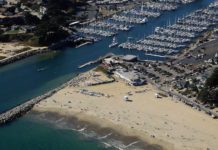Late August 18th, I finished my latest article, “A Perfect Storm for Fire.” Throughout that Tuesday, I gained more motivation for the piece, as smoke gradually obscured our valley from my window. At the time, the fires throughout the county seemed manageable. Robert Gray, the Felton Fire Protection District Chief assured, “We’ve sent assistance to neighboring agencies, but in Felton we’ve had no fires. We’ve just chased a few fallen trees and power lines.” However, concern for air quality soon paled in comparison with the Tuesday night evacuations of all Boulder Creek residents. Countless other neighborhoods soon followed.
Before this, I didn’t think 2% containment wouldn’t be a cause for joy. However, after four days of 0% containment, many breathed a sigh of relief upon hearing the announcement from CAL FIRE. 20 days after the lightning strikes began this fire complex, it’s now stable enough for accurate statistical analysis by CAL FIRE. While statistics will never truly capture the pain of losing one’s home, the work ethic of a firefighter, or the relief felt for a loved one’s safety, let’s delve into the numbers behind this natural disaster and the people who have worked so hard to fight against it.
At this point, 85,467 acres have burned in Santa Cruz and San Mateo Counties in the 20 days since the fire began.
We’ve reached almost 50% containment with the help of:
- 12 helicopters
- 209 fire engines
- 10 bull dozers
- 32 water tenders
- and 54 crews made up of 2,431 extraordinarily brave men and women.
More than 900 homes have been lost in the fire, almost 400 “minor structures,” and about 170 businesses. Almost 100 homes and less than 20 businesses have been damaged from the fires, but so countless buildings have been saved by the hard work of our fire departments.
Over 60,000 individuals were evacuated over the course of the fire and many still cannot return home. However, repopulation efforts began on August 26th. So far, UCSC, Scotts Valley, Zayante, Mount Hermon, Felton, and Ben Lomond have returned home.
For those zones still evacuated, the process to return appears long and arduous. According to CAL FIRE, “Many known and unknown hazards exist following an intense fire. This includes fire weakened or dead trees that can fall without warning, burned out stumps creating holes under trails and damage to parking areas and roads.” The Third District Supervisor, Ryan Coonerty, summed up the repopulation efforts in highly impacted areas, “CAL FIRE and the County will need to assess all the roadways, the trees along the roadway and hillsides. Power and water will need to be restored. Each housing site will need to be inspected. In addition, the state will clean up toxic materials and then the state/county would contract, if homeowners agree, to do debris removal. This process can take months. It is at this point that access will be allowed.”
Water is another serious concern for returning evacuees. The San Lorenzo Valley Water District (SLVWD) has faced difficulty in maintaining their water supplies and providing fire fighters with vast amounts of water. The Water District Director, Rick Rogers, reported a loss of 4.5 million gallons due to fire damage. On top of the water loss, many homes don’t have safe, potable water. A few high-density polyethylene water mainlines were destroyed by the fire, “causing widespread depressurization,” that can “introduce contaminants into the system.” Brookdale and areas north from the intersection of Highway 9 and Alba Road are potentially affected by this contamination and should not drink water from their homes. However, most homeowners should have access to water upon returning after evacuation, but the District suggests, “flushing your home’s front hose bib by running an outside faucet for about 5 minutes upon returning back home from evacuation.”
The Fifth District Supervisor Bruce McPherson also spoke to CAL FIRE and had much advice for returning evacuees:
- When driving, watch for trees, brush and rocks that are weakened or loosened. Be aware of debris or damage on roads and driveways. Traffic may be delayed or lanes reduced due to repair and firefighter operations.
- Use extreme caution around trees, power poles and other tall objects or structures that may have been weakened. Be aware that trees with deep charring are weakened. Smoldering holes in the ground can be full of hot coals and white ash.
- Before inspecting your home, check for the smell of gas. Use a battery-powered flashlight to inspect a damaged home. Check for hot embers in rain gutters, on the roof, under overhangs, under decks, crawl spaces and attics. Be sure your wood and debris piles are not hiding any embers.
- If electricity is off, before turning it on, make sure all appliances are turned off. If the electric meter has visible damage, do not turn the breakers on. If there are electrical wires on the ground, stay clear.
- Do not drink water from the faucet until officials say it is safe.
- Discard food that has been exposed to heat, smoke, flood waters or soot. Refrigerated items are also spoiled and need to be discarded.
- If you have a propane tank or natural gas, heating oil tank system, or solar electrical system, do not use them before proper inspection by a licensed technician
For the folks lucky enough to return to our beautiful community, welcome back. For the folks still waiting to return home, we hope to see you soon. For those who have lost their homes, we are so sorry for your loss, but so glad you are safe.
Here are a few vital resources for our community:
- For more updates on the CZU Lightning Fire Complex, check out the CAL FIRE Twitter at https://twitter.com/CALFIRECZU.
- For a map of evacuated zones, visit https://tinyurl.com/y3zc8hpt.
- For a map of structures damaged in the fire, see https://www.santacruzcounty.us/FireRecovery/DamageAssessmentMap.aspx.
- For evacuees that need help finding a place to stay, you can call the County Hotel Hotline, 831-454-2181.













